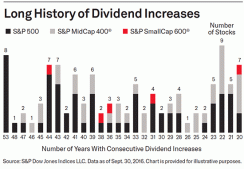To view a PDF of the report, click here.
Dividend strategies have gained a foothold with market participants seeking potential outperformance and attractive yields.
While traditional high dividend payers have performed strongly in recent years, they have become quite expensive. The previous low-interest-rate environment paved the way for many of these businesses to load up on debt, while continuing to pay high dividends. As a result, many of these companies may come under pressure when rates rise.
Stocks with a history of dividend growth, on the other hand, could present a compelling investment opportunity in an environment of potential volatility and rising rates. An allocation to companies that have sustainable and growing dividends may provide exposure to high-quality stocks and greater income over time.
This argument goes beyond the traditional realm of domestic large-cap stocks. It also works for small- and mid-cap stocks and can be applied to international markets as well. The S&P High Yield Dividend Aristocrats is designed to track a basket of stocks from the S&P Composite 1500 that have consistently increased their dividends every year for at least 20 years.
Why dividend growers?
Dividend growth stocks tend to be of higher quality than those of the broader market in terms of earnings quality and leverage.
While the hurdle for inclusion in the S&P High Yield Dividend Aristocrats index inclusion is 20 straight years of increasing dividends, the index average is 34.5 years. Additionally, there are eight constituents with over 53 consecutive years of dividend increases.
Dividend growth stocks could also be attractive to market participants looking for disciplined companies that can endure difficult market and economic environments relatively well.
In particular, dividend growers may provide some downside protection during bearish markets. Looking at the period from Dec. 31, 1999, to Sept. 30, 2016, when the market (as represented by the S&P Composite 1500 was down, the S&P High Yield Dividend Aristocrats outperformed the S&P Composite 1500, and the S&P 500 High Dividend Index by an average of 165 bps per month and 54 bps per month, respectively.

In addition, dividend growth strategies could potentially address the concerns surrounding the performance of high dividend payers in a rising rate environment. Because of the focus on increasing dividends rather than high yield, the performance of dividend growers is less driven by the value factor compared with the high dividend payers. Second, unlike many pure yield strategies, which tend to be concentrated in sectors like utilities, consumer staples, and financials, dividend growth strategies tend to be more diversified across sectors, and the sector composition tends to be stable across time.
In summary, for market participants focusing on U.S. equities but worried about volatility and the potential of rising rates, the S&P High Yield Dividend Aristocrats could provide a dividend growth solution.
S&P Dow Jones Indices contributors:
Tianyin Cheng, Associate Director, Strategy Indices
Vinit Srivastava, Head of Strategy & Volatility Indices
Copyright © 2017 S&P Dow Jones Indices LLC, a division of S&P Global. All rights reserved. Redistribution, reproduction and/or photocopying in whole or in part are prohibited without written permission. Standard & Poor’s and S&P are registered trademarks of Standard & Poor’s Financial Services LLC, a division of S&P Global (“S&P”); Dow Jones is a registered trademark of Dow Jones Trademark Holdings LLC (“Dow Jones”); and these trademarks have been licensed for use by S&P Dow Jones Indices LLC. S&P Dow Jones Indices LLC, Dow Jones, S&P and their respective affiliates (“S&P Dow Jones Indices”) makes no representation or warranty, express or implied, as to the ability of any index to accurately represent the asset class or market sector that it purports to represent and S&P Dow Jones Indices shall have no liability for any errors, omissions, or interruptions of any index or the data included therein. Past performance of an index is not an indication of future results. This document does not constitute an offer of any services. All information provided by S&P Dow Jones Indices is general in nature and not tailored to the needs of any person, entity or group of persons. S&P Dow Jones Indices receives compensation in connection with licensing its indices to third parties. It is not possible to invest directly in an index. Exposure to an asset class represented by an index may be available through investable instruments offered by third parties that are based on that index. S&P Dow Jones Indices does not sponsor, endorse, sell, promote or manage any investment fund or other investment product or vehicle that seeks to provide an investment return based on the performance of any Index. S&P Dow Jones Indices LLC is not an investment or tax advisor. S&P Dow Jones Indices makes no representation regarding the advisability of investing in any such investment fund or other investment product or vehicle. A tax advisor should be consulted to evaluate the impact of any tax-exempt securities on portfolios and the tax consequences of making any particular investment decision. For more information on any of our indices please visit www.spdji.com.





